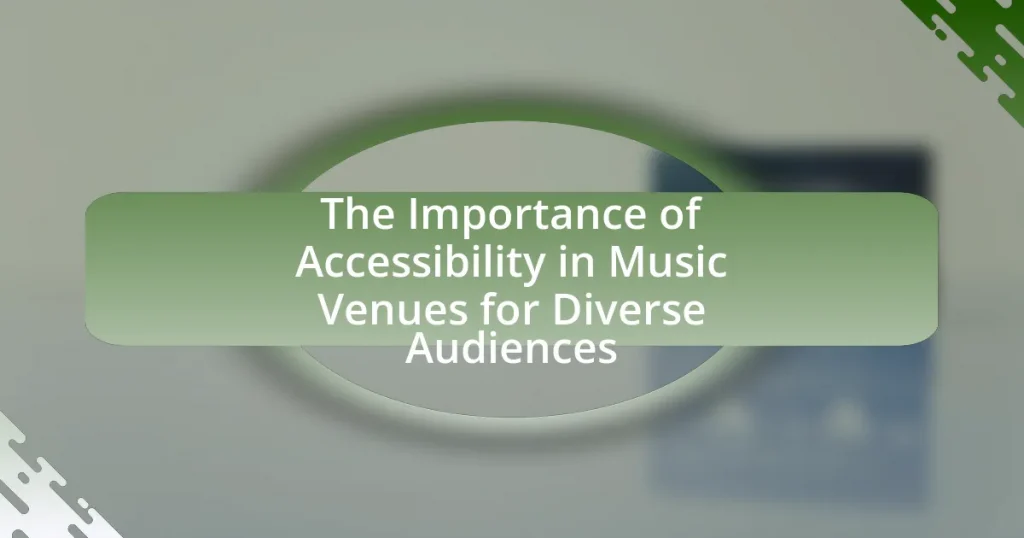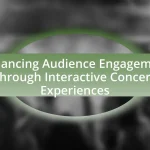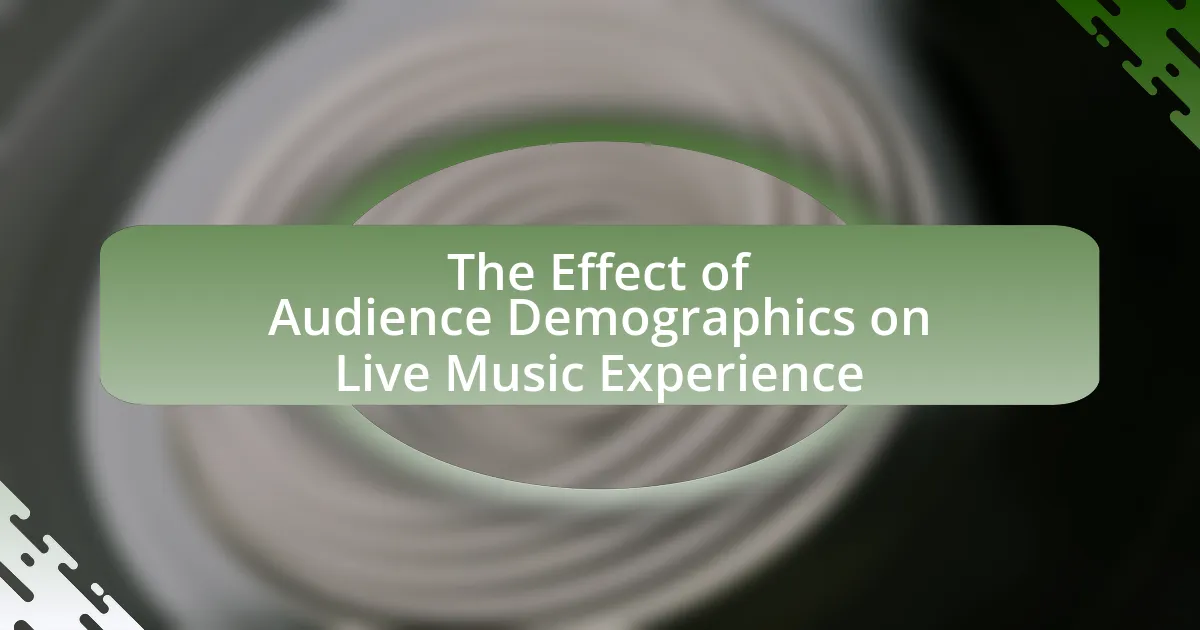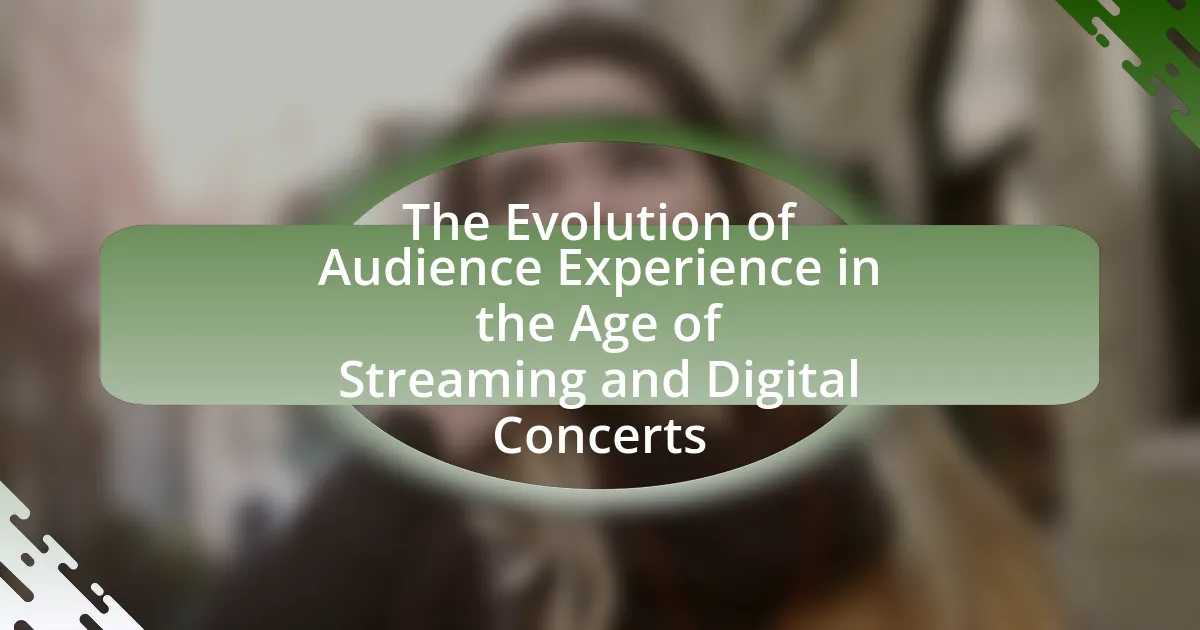Accessibility in music venues is essential for accommodating diverse audiences, including individuals with disabilities, which represent approximately 15% of the global population. The article outlines the importance of implementing features such as wheelchair ramps, accessible seating, and assistive listening devices to foster inclusivity and enhance audience attendance. It discusses legal requirements under the Americans with Disabilities Act (ADA) and highlights the economic advantages of accessible venues, including increased patronage and improved community engagement. Additionally, the article addresses the challenges venues face in becoming accessible and emphasizes the role of community feedback in shaping effective accessibility initiatives.

What is the Importance of Accessibility in Music Venues for Diverse Audiences?
Accessibility in music venues is crucial for ensuring that diverse audiences can fully participate in cultural experiences. This importance is underscored by the fact that approximately 15% of the global population lives with some form of disability, which necessitates the implementation of features such as wheelchair ramps, accessible seating, and assistive listening devices. Furthermore, accessible venues foster inclusivity, allowing individuals from various backgrounds, including those with mobility challenges, hearing impairments, and sensory sensitivities, to enjoy performances. Research indicates that when venues prioritize accessibility, they not only comply with legal standards but also enhance their audience reach and overall attendance, as seen in studies showing that inclusive practices can increase patronage by up to 20%. Thus, the importance of accessibility in music venues lies in its ability to create equitable opportunities for enjoyment and engagement among all community members.
Why is accessibility crucial for music venues?
Accessibility is crucial for music venues because it ensures that all individuals, regardless of physical ability, can participate in and enjoy live performances. By implementing features such as wheelchair ramps, accessible seating, and assistive listening devices, venues can accommodate a wider audience, thereby increasing attendance and fostering inclusivity. According to the Americans with Disabilities Act (ADA), public venues are required to provide equal access to individuals with disabilities, which not only promotes social equity but also enhances the venue’s reputation and financial viability. Studies show that accessible venues can see a significant increase in patronage, as they attract diverse audiences who might otherwise be excluded.
What are the different types of disabilities that need to be considered?
The different types of disabilities that need to be considered include physical disabilities, sensory disabilities, intellectual disabilities, and mental health disabilities. Physical disabilities may involve mobility impairments, requiring wheelchair access and appropriate seating arrangements. Sensory disabilities encompass visual and hearing impairments, necessitating features like braille signage and assistive listening devices. Intellectual disabilities refer to limitations in cognitive functioning, which may require simplified communication and support. Mental health disabilities can affect a person’s ability to engage in social situations, highlighting the need for supportive environments. Each type of disability presents unique challenges that must be addressed to ensure accessibility in music venues for all audiences.
How does accessibility impact audience attendance and experience?
Accessibility significantly enhances audience attendance and experience by ensuring that all individuals, regardless of physical or cognitive abilities, can participate fully in events. When music venues implement features such as wheelchair ramps, accessible seating, and assistive listening devices, they attract a broader audience, including those with disabilities. According to a study by the National Endowment for the Arts, accessible venues see a 20% increase in attendance from individuals with disabilities compared to those that lack such accommodations. This increase not only boosts ticket sales but also enriches the overall experience for all attendees, fostering an inclusive environment that encourages diverse participation and engagement.
What are the legal requirements for accessibility in music venues?
Music venues are legally required to comply with the Americans with Disabilities Act (ADA), which mandates that public accommodations, including entertainment venues, must be accessible to individuals with disabilities. This includes providing accessible seating, restrooms, and pathways, as well as ensuring that services and programs are available to all patrons. The ADA requires that at least one accessible route be provided to all areas of the venue, and that a certain percentage of seating be designated as accessible. Additionally, venues must offer assistive listening devices and ensure that staff are trained to assist patrons with disabilities. Compliance with these requirements is essential for legal operation and to promote inclusivity for diverse audiences.
What laws govern accessibility in public spaces?
The laws that govern accessibility in public spaces include the Americans with Disabilities Act (ADA) and the Rehabilitation Act of 1973. The ADA mandates that public facilities must be accessible to individuals with disabilities, ensuring equal access to services and opportunities. The Rehabilitation Act prohibits discrimination based on disability in programs receiving federal funding, reinforcing the need for accessible public spaces. These laws collectively establish standards for design and construction, requiring features such as ramps, accessible restrooms, and designated seating areas to accommodate diverse audiences in venues, including music venues.
How do these laws vary by region or country?
Laws regarding accessibility in music venues vary significantly by region and country, reflecting differing legal frameworks and cultural attitudes towards disability rights. For instance, the Americans with Disabilities Act (ADA) in the United States mandates specific accessibility standards for public venues, while the Equality Act 2010 in the United Kingdom provides similar protections but may differ in implementation and enforcement. In contrast, countries like Japan have their own regulations, such as the Act on the Elimination of Discrimination against Persons with Disabilities, which emphasizes accessibility but may not be as comprehensive as the ADA. These variations can impact the extent to which music venues accommodate diverse audiences, influencing everything from physical access to services provided for individuals with disabilities.
What are the benefits of making music venues accessible?
Making music venues accessible benefits both the audience and the venue operators by increasing attendance and fostering inclusivity. Accessible venues allow individuals with disabilities to enjoy performances, which can lead to a broader audience base and higher ticket sales. According to a study by the National Endowment for the Arts, accessible venues can increase attendance by up to 25% among people with disabilities. Furthermore, creating an inclusive environment enhances the reputation of the venue, attracting diverse audiences and promoting community engagement.
How does accessibility enhance the overall experience for all attendees?
Accessibility enhances the overall experience for all attendees by ensuring that everyone, regardless of ability, can fully participate in events. When music venues implement features such as wheelchair ramps, accessible seating, and assistive listening devices, they create an inclusive environment that fosters enjoyment and engagement for diverse audiences. Research indicates that inclusive practices not only benefit individuals with disabilities but also enhance the experience for all attendees by promoting a sense of community and shared enjoyment. For example, a study by the National Endowment for the Arts found that accessible venues attract larger audiences, leading to increased ticket sales and a more vibrant atmosphere.
What economic advantages do accessible venues offer to owners?
Accessible venues provide economic advantages to owners by expanding their customer base and increasing revenue potential. By accommodating individuals with disabilities, these venues tap into a significant market; approximately 15% of the global population lives with some form of disability, according to the World Health Organization. This inclusivity not only enhances attendance but also fosters positive brand reputation and loyalty among diverse audiences. Furthermore, accessible venues may qualify for government incentives or grants aimed at promoting inclusivity, thereby reducing operational costs.
How can music venues improve their accessibility?
Music venues can improve their accessibility by implementing features such as wheelchair ramps, accessible seating, and assistive listening devices. These modifications ensure that individuals with mobility impairments can enter, navigate, and enjoy performances comfortably. According to the Americans with Disabilities Act (ADA), venues are required to provide accessible facilities, which includes ensuring that at least 1% of seating is designated for individuals with disabilities. Additionally, staff training on assisting patrons with disabilities can enhance the overall experience, as evidenced by studies showing that inclusive practices lead to increased attendance and customer satisfaction.
What specific features should be implemented for better accessibility?
To improve accessibility in music venues for diverse audiences, specific features such as wheelchair ramps, accessible seating, and assistive listening devices should be implemented. Wheelchair ramps ensure that individuals with mobility impairments can enter and navigate the venue easily, while accessible seating provides designated areas for those who require additional space or support. Assistive listening devices enhance the experience for patrons with hearing impairments by amplifying sound and reducing background noise. According to the Americans with Disabilities Act (ADA), these features are essential for compliance and to create an inclusive environment for all attendees.
How can staff training contribute to a more inclusive environment?
Staff training can significantly contribute to a more inclusive environment by equipping employees with the knowledge and skills necessary to understand and address the diverse needs of all patrons. Training programs that focus on diversity, equity, and inclusion help staff recognize unconscious biases and develop empathy towards individuals from various backgrounds, including those with disabilities. For instance, a study by the National Endowment for the Arts found that organizations with comprehensive training on accessibility reported higher satisfaction rates among diverse audiences. This indicates that well-trained staff can create a welcoming atmosphere, ensuring that all attendees feel valued and included in music venues.
What challenges do music venues face in becoming accessible?
Music venues face significant challenges in becoming accessible, primarily due to financial constraints, structural limitations, and regulatory compliance. Financially, many venues struggle to allocate funds for necessary renovations or technology upgrades that enhance accessibility, such as ramps, elevators, and accessible restrooms. Structurally, older buildings often lack the foundational designs to accommodate accessibility features, making retrofitting difficult and costly. Additionally, navigating the complex landscape of local, state, and federal regulations regarding accessibility can be overwhelming for venue operators, leading to inconsistent implementation of required standards. These challenges collectively hinder the ability of music venues to provide an inclusive experience for all audiences.
What are common misconceptions about accessibility in music venues?
Common misconceptions about accessibility in music venues include the belief that accessibility only pertains to physical disabilities, that all venues are already compliant with accessibility standards, and that providing accessible options is prohibitively expensive. Accessibility encompasses a range of needs, including sensory and cognitive disabilities, not just mobility issues. Furthermore, many venues may not meet the requirements set by the Americans with Disabilities Act (ADA), which can lead to inadequate accommodations. Lastly, studies show that implementing accessibility features can be cost-effective and may even increase attendance by attracting a broader audience, demonstrating that the initial investment can yield significant returns.
How can venues overcome financial barriers to improve accessibility?
Venues can overcome financial barriers to improve accessibility by seeking funding through grants, partnerships, and community support. Many organizations, such as the National Endowment for the Arts, offer grants specifically aimed at enhancing accessibility in public spaces. Additionally, venues can collaborate with local businesses and nonprofits to share costs and resources, thereby reducing the financial burden. Implementing tiered pricing models for events can also help generate revenue while making accessibility features more affordable. According to a report by the Americans with Disabilities Act National Network, investing in accessibility can lead to increased attendance and customer loyalty, ultimately benefiting the venue financially.
What role do community feedback and involvement play in accessibility efforts?
Community feedback and involvement are crucial in accessibility efforts as they ensure that the needs and preferences of diverse audiences are accurately represented and addressed. Engaging with community members allows organizations to identify specific barriers faced by individuals with disabilities, leading to more effective and tailored solutions. For instance, a study by the National Endowment for the Arts found that venues that actively sought input from patrons with disabilities were more successful in implementing meaningful accessibility improvements, such as better seating arrangements and enhanced audio-visual aids. This collaborative approach not only fosters a sense of ownership among community members but also enhances the overall experience for all attendees, demonstrating the direct impact of community involvement on accessibility initiatives.
How can venues engage with diverse audiences to understand their needs?
Venues can engage with diverse audiences to understand their needs by implementing targeted outreach programs and conducting surveys. Targeted outreach programs, such as community forums and focus groups, allow venues to gather direct feedback from various demographic groups, ensuring that their voices are heard. Surveys can be distributed both online and at events, collecting data on audience preferences, accessibility concerns, and cultural considerations. Research indicates that venues that actively seek input from diverse communities see increased attendance and satisfaction, as evidenced by a study from the National Endowment for the Arts, which found that inclusive practices lead to a 20% increase in audience engagement.
What are effective ways to gather and implement feedback from attendees?
Effective ways to gather and implement feedback from attendees include utilizing surveys, conducting focus groups, and engaging in direct conversations. Surveys, both online and paper-based, allow for quantitative data collection, enabling venues to analyze trends and specific areas for improvement. Focus groups provide qualitative insights, allowing attendees to express their experiences and suggestions in a more detailed manner. Direct conversations, whether through informal discussions or structured interviews, foster a personal connection and can yield immediate feedback. Implementing this feedback involves prioritizing actionable items, communicating changes to attendees, and continuously monitoring the effectiveness of these changes to ensure ongoing improvement in accessibility for diverse audiences.
What are best practices for ensuring accessibility in music venues?
Best practices for ensuring accessibility in music venues include implementing physical modifications, providing assistive technologies, and training staff on accessibility awareness. Physical modifications such as ramps, elevators, and accessible seating ensure that individuals with mobility impairments can navigate the venue comfortably. The use of assistive technologies, like hearing loops and captioning services, enhances the experience for those with hearing impairments. Additionally, training staff on accessibility protocols fosters an inclusive environment, ensuring that all patrons receive the assistance they need. These practices are supported by the Americans with Disabilities Act (ADA), which mandates accessibility standards for public venues, demonstrating the legal and ethical obligation to accommodate diverse audiences.
How can venues create a welcoming atmosphere for all audiences?
Venues can create a welcoming atmosphere for all audiences by implementing inclusive design features and fostering a culture of respect and understanding. Inclusive design features include accessible entrances, seating arrangements that accommodate individuals with disabilities, and clear signage that aids navigation. For instance, the Americans with Disabilities Act (ADA) mandates that public venues provide accessible facilities, which has been shown to increase attendance from diverse groups. Additionally, fostering a culture of respect involves training staff to be sensitive to the needs of all patrons, ensuring that everyone feels valued and included. Research indicates that venues that prioritize inclusivity not only enhance the experience for diverse audiences but also improve overall customer satisfaction and loyalty.
What resources are available for venues looking to enhance accessibility?
Venues looking to enhance accessibility can utilize resources such as the Americans with Disabilities Act (ADA) guidelines, which provide comprehensive standards for accessible design. These guidelines help venues understand the legal requirements and best practices for accommodating individuals with disabilities. Additionally, organizations like the National Association of Secretaries of State (NASS) offer resources and training on accessibility best practices. The National Endowment for the Arts also provides funding opportunities specifically aimed at improving accessibility in arts venues. These resources collectively support venues in creating inclusive environments that cater to diverse audiences.




